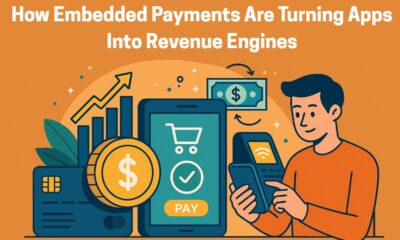Finance
High-Risk Merchant Accounts: How to get them in 2022?

High-risk merchant accounts are payment processing services that enable high-risk enterprises to accept credit card payments from consumers. Businesses classified as high risk are unlikely to be approved for a traditional merchant account, necessitating the use of a dedicated account. Though high-risk merchant accounts usually have higher fees than standard accounts, the best ones include transparent pricing, specialized customer assistance, and chargeback prevention features.
[lwptoc]
What does a High-Risk Merchant Account entail?
A high risk merchant account is a collection of services that allow businesses in high-risk sectors to accept credit card payments from their customers. These accounts usually have more demanding criteria and limitations than regular merchant accounts, and they are more expensive to manage.
Processor options for high-risk businesses are restricted. They will also have to pay more outstanding fees to compensate for the perceived risk and deal with more stringent contracts.
At first, appearance, being designated “high-risk,” seems to be a terrible thing. However, it may be your best (or only) alternative in other cases.
What Constitutes a High-Risk Business?
Being a ‘high-risk’ merchant does not always imply that your company is more untrustworthy than others. It means that processors see a more significant number of conflicts in your industry. It doesn’t reflect your company’s worthiness.
Steps to Obtaining a High-Risk Merchant Account
Companies that do research: There is a lot of rivalry among high-risk merchant account providers, just as there is with other commercial services. To locate the greatest, conduct your research and choose one that meets your company’s requirements.
There are two primary methods for identifying a high-risk payment processor. The search results will produce a list of many viable candidates for your account.
The second method is to do a more exhaustive search for high-risk merchant accounts. Some of these businesses are brokerages that link you to a banking partner willing to open an account for you. Regardless of the account provider, you should ensure that they can enroll your unique organization.
-
Contact a Firm
After you’ve identified a few respectable organizations, contact a couple of them to discover more about how they can assist you. Customer service is critical in this situation. Your high-risk merchant account provider connects to your company’s bank account and income stream. You’ll want to ensure that the folks you deal with are knowledgeable and can answer any concerns you have regarding costs, approval times, or gateway integrations.
-
Fill Out An Application
The high-risk industry is built on recognizing certain features that may result in inefficiencies in your interactions. Banks gather information about your organization to understand it better and predict and mitigate these challenges. It entails a thorough application procedure for high-risk merchant account providers.
-
Introductory Phone Call
Your initial conversation with the merchant account staff may occur anytime you want to call and learn more. However, the phone call on this list refers to a security check. After completing the application, a customer service person will contact you to verify your information. It is done as a security step to limit the number of fraudulent applications.
COAs for CBD firms, articles of incorporation, or particular comments regarding your prior processes may be included as additional documentation. A provider may need confirmation that both the corporation and the business owner are in the same nation and have current social security numbers in specific situations. Because there are different restrictions for foreign processing, banks will want to gather particular facts before proceeding with your account.
-
Bank Review
Following submitting your application and papers, your high-risk merchant account provider will offer your bank package on your behalf. This evaluation procedure may take as little as two days, but it can also take up to 10 business days. The processing time is determined by your firm and the resources available to banks to evaluate the information you’ve given.
If there is an influx of new applications, regulatory changes, or internal audits at the bank, the procedure may slow. The high-risk merchant account business you choose to engage with will keep you updated on progress and ensure that your application goes through all of the appropriate processes.
Stipulations: A bank may often seek further information or adjustments to your items or website. For example, if you’re selling nutraceuticals, you won’t be able to use text with unapproved medical claims. Here are some examples of CBD corporate requirements:
- Current Utility Bill – Including the Company’s Address
- Proof of Domain Ownership – a screenshot or an email containing the owner’s or business’s name.
- COAs (Certificates of Analysis) for each CBD product sold online, tagged with the product name as it appears on your website, issued by the state.
-
Underwriting
If your application has been sent to underwriting, you are just one step away from approval. The bank prepares your agreement and changes its side of your account to ensure that your transactions go smoothly. They will also finalize any service costs and include your special rates into their platform, allowing you to monitor your volume and pricing appropriately.
-
Approval
Once underwriting is through, your account is ready to go. Your high-risk processor will contact you to let you know that your company has been authorized. You’ll be able to accept payments and monitor money generated on your website right away. You will also get access to a payment site where you can see every transaction over time and track vital information such as chargebacks or refunds.
-
Process Your Payments
Setting up your account is a one-time commitment. However, to keep your account open, be sure to adhere to your bank’s agreements set in place. If you add new goods to your website or make changes to your brand, be sure to notify your payment processing team so that they can keep up with your expanding company.
Conclusion
Processing payments is an essential component of operating an eCommerce store, whether you’re a startup or a well-established organization. There are several merchant account providers, but it is crucial to pick one appropriate for your company. To ensure the successful operation of your company, you should adhere to the terms and conditions of your account agreement. High-risk businesses who join up with mainstream payment providers often don’t qualify, but they don’t realize it until it’s too late.
Check out: The Best Payment Processors for High-Risk Merchants in 2021
-

 Business2 months ago
Business2 months agoTech Capital One: Careers, Jobs, and Opportunities
-

 Digital Marketing2 months ago
Digital Marketing2 months agoHow Embedded Payments Are Turning Apps Into Revenue Engines
-

 Tech1 month ago
Tech1 month agoSora 2 Invite Code: How to Get One (Step-by-Step Guide)
-

 Real Estate2 months ago
Real Estate2 months agoDigital Tools That Are Changing the Way We Relocate






